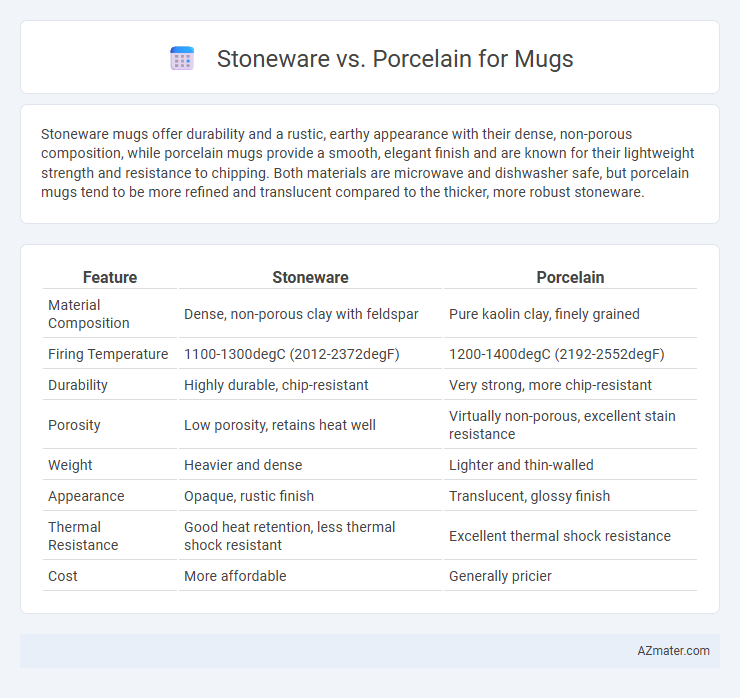Stoneware mugs offer durability and a rustic, earthy appearance with their dense, non-porous composition, while porcelain mugs provide a smooth, elegant finish and are known for their lightweight strength and resistance to chipping. Both materials are microwave and dishwasher safe, but porcelain mugs tend to be more refined and translucent compared to the thicker, more robust stoneware.
Table of Comparison
| Feature | Stoneware | Porcelain |
|---|---|---|
| Material Composition | Dense, non-porous clay with feldspar | Pure kaolin clay, finely grained |
| Firing Temperature | 1100-1300degC (2012-2372degF) | 1200-1400degC (2192-2552degF) |
| Durability | Highly durable, chip-resistant | Very strong, more chip-resistant |
| Porosity | Low porosity, retains heat well | Virtually non-porous, excellent stain resistance |
| Weight | Heavier and dense | Lighter and thin-walled |
| Appearance | Opaque, rustic finish | Translucent, glossy finish |
| Thermal Resistance | Good heat retention, less thermal shock resistant | Excellent thermal shock resistance |
| Cost | More affordable | Generally pricier |
Introduction to Stoneware and Porcelain Mugs
Stoneware mugs are crafted from dense clay fired at high temperatures, providing durability and a slightly textured, rustic finish ideal for everyday use. Porcelain mugs, made from refined clay fired at even higher temperatures, deliver a smooth, translucent surface with superior strength and chip resistance, suitable for elegant settings. Both materials offer heat retention and aesthetic appeal, but their differences in texture, weight, and finish make each uniquely suited to different preferences and uses.
Material Composition and Manufacturing Process
Stoneware mugs are crafted from dense clay fired at high temperatures between 1,100degC and 1,300degC, resulting in a durable, non-porous material with a slightly coarse texture. Porcelain mugs utilize a refined mixture of kaolin clay fired at even higher temperatures around 1,200degC to 1,400degC, producing a smooth, translucent, and highly vitrified surface. The manufacturing process for porcelain involves precise control to achieve its delicate strength and whiteness, while stoneware's firing process emphasizes robustness and rustic appeal.
Durability and Strength Comparison
Stoneware mugs offer exceptional durability due to their dense, non-porous clay body, making them resistant to chips and cracks from daily use. Porcelain mugs feature a fine, vitrified composition that provides superior strength and a smooth, glass-like surface, yet they can be more prone to chipping under heavy impact. Both materials withstand high temperatures well, but stoneware's robustness makes it preferable for long-term durability while porcelain excels in strength with a delicate finish.
Heat Retention and Insulation Properties
Stoneware mugs typically offer superior heat retention due to their thicker walls and denser clay composition, which traps heat more effectively than porcelain. Porcelain mugs, while often more delicate and thinner, provide moderate insulation but can lose heat faster because of their finer, less porous structure. For those prioritizing warmth and durability during extended beverage consumption, stoneware remains the optimal choice.
Weight and Handling Differences
Stoneware mugs are typically heavier and more robust due to their dense, coarse clay composition, providing a substantial, grounded feel in hand that appeals to those who prefer a sturdy grip. Porcelain mugs are lighter and smoother, crafted from finer clay fired at higher temperatures, resulting in a more delicate, refined handle experience that enhances ease of use and elegance. The weight difference affects thermal retention and handling comfort, with stoneware offering better heat insulation but porcelain excelling in lightweight portability.
Aesthetic Qualities and Finish
Stoneware mugs feature a rustic, earthy aesthetic with a matte or slightly textured finish that emphasizes natural variations and handcrafted appeal. Porcelain mugs exhibit a sleek, smooth surface with a glossy, refined finish that enhances elegance and a delicate appearance. Both materials offer durable qualities, but porcelain provides a more polished look while stoneware showcases warmth and artisanal charm.
Porosity and Stain Resistance
Porcelain mugs feature low porosity, making them highly resistant to stains and bacterial absorption compared to stoneware. Stoneware, with its higher porosity, tends to absorb liquids and colors more easily, leading to potential staining over time. This characteristic makes porcelain mugs more durable and easier to maintain, especially for daily use with coffee or tea.
Cost and Value Considerations
Stoneware mugs generally offer a lower cost compared to porcelain, making them an affordable choice for everyday use without sacrificing durability. Porcelain mugs, though more expensive, provide a refined aesthetic and higher resistance to chipping, enhancing long-term value. Choosing between stoneware and porcelain depends on budget constraints and the desired balance between cost efficiency and premium quality.
Best Uses and Suitability
Stoneware mugs, known for their durability and rustic appeal, are best suited for everyday use and casual settings due to their thicker walls and ability to retain heat longer. Porcelain mugs, characterized by their smooth, translucent finish and lighter weight, excel in more formal or refined environments and are ideal for serving delicate teas or specialty coffee. Both materials offer excellent resistance to thermal shock, but porcelain's non-porous surface makes it more resistant to stains and odors, enhancing its suitability for frequent washing and varied beverage choices.
Conclusion: Which Mug is Right for You?
Stoneware mugs offer durability and a rustic aesthetic, ideal for those who prefer a heavy, handcrafted feel and excellent heat retention. Porcelain mugs provide a sleek, lightweight option with superior chip resistance and a smooth finish, perfect for a refined, modern look and everyday use. Your choice depends on whether you value durability and warmth or elegance and convenience in your drinking experience.

Infographic: Stoneware vs Porcelain for Mug
 azmater.com
azmater.com